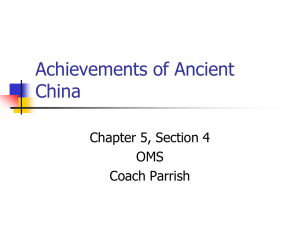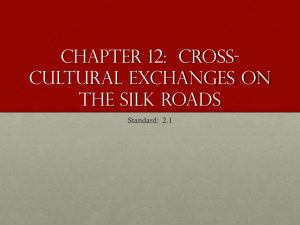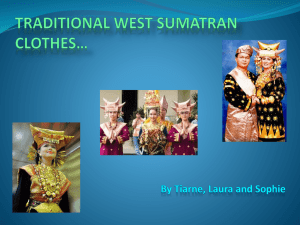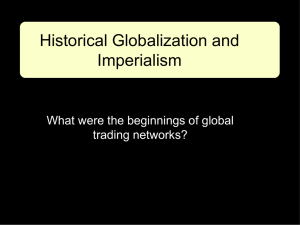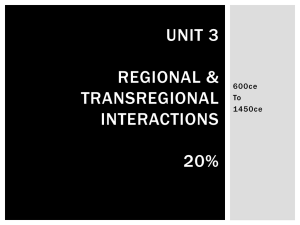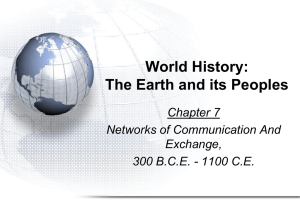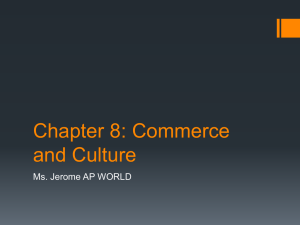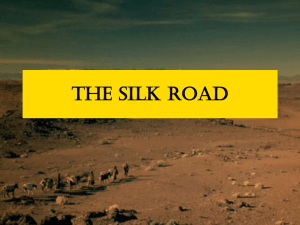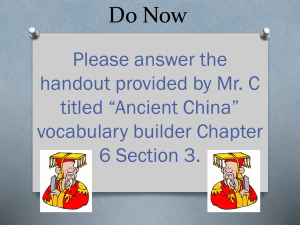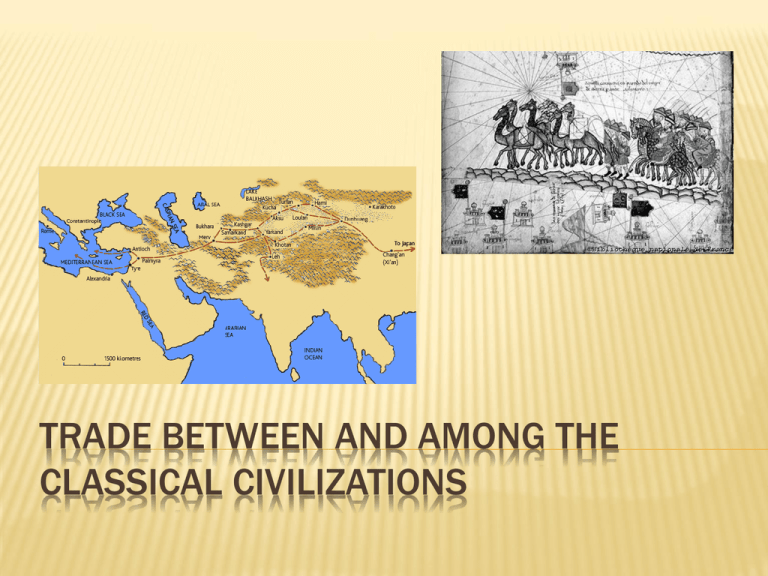
TRADE BETWEEN AND AMONG THE
CLASSICAL CIVILIZATIONS
What did the Indians
trade?
Cultural
Commercial
Technological
• Art: Hellenistic
• Science:
Mathematics +
Astronomy (export)
• Religion: Buddhism
spreads; few Hindu
converts
• From India:
• Spices
• Ivory
• Jade
• Textile
• Pepper
• Into India:
• Silk
• Gold and Silver
bullion
• Paper
• Medicine
• Warfare methods
• Ayurveda
• Architecture
• Civil engineering
• Ship building
WHO DID THEY TRADE WITH?
Malay
Greek
Bactria
Chinese
Arabs
Romans
WHO DID THEY TRADE WITH?
Not part of the main Silk Road, however, active regional trade
MEDITERRANEAN TRADE (WHAT)
What they traded:
Animals
Agricultural Products
Wine
Slaves
Amber
Iron
Gemstones
pottery
MEDITERRANEAN TRADE (HOW AND WHO)
Spanned Persia, Egypt,
Rome, and India
On land and sea
Ideas: Hellenism
Goods: numbers, and
writing systems
Hellenism, numbers,
writing systems, =
explosion of intellectual
activity
Idea of Monotheism
WHO THE CHINESE TRADED WITH
-
-
-
-
Ancient Europe country knew China even there wasn’t trade between
China and ancient western country. Because when the period was
Qin Dynasty, they built the Great Wall. As you know word “China” is
from Qin dynasty which is the Persian and the Greek.
Silk road wasn’t found accidently. After China has been civilized, they
found way to get to the northern Europe, however, trade was
prevalent in Han Dynasty in the second century BC, the Chinese were
regularly trading silk and grain for horses and jade with the western
barbarians .
Main ancient country that trade with China:
Greek
Roman
Persian
Indian
WHAT THE CHINESE WANTED…
WHAT THE PARTHIANS/ARABIANS/ROMANS
WANTED…
WHAT ARE THE SILK ROADS?
What are the Silk Roads?
-a series of trade routes that connect the East,
South, and Western Asia (the “Orient”) with the
Mediterranean, Europe, and North Africa (the
“West”)
Why “Silk Road?”
-the name derives from silk trade with China, popular
during the classical period
Source: Spodek, Howard. The World's History. Upper Saddle River, NJ: Pearson/Prentice Hall, 2006. Print.
WHERE ARE THE SILK ROADS?
Map Source: Spodek, Howard. "Eurasian Trade." Map. The World's History. Upper Saddle River: Prentice Hall, 2006. 183. Print.
Mainstream + Sidestream
from Southern Europe through Arabia, Somalia,
Egypt, Persia, Pakistan, India, Bangladesh, Java, and
Vietnam, and China *Note Bactria
WHY WERE THEY IMPORTANT?
Was a main cite of cultural, commercial, and
technological exchange between classical civilizations
The traded commodities, ideas, and cultures affected
classical civilizations significantly
ex) Buddhism from India to China
silk, bronze, Indian textiles, world religions, epidemics,
etc.
The exchange, starting at around 300 BCE, lasted until
around European colonialism (some routes still in
function)
Source: Spodek, Howard. The World's History. Upper Saddle River, NJ: Pearson/Prentice Hall, 2006. Print.
DISCUSS ROLE OF NOMADS IN SILK ROAD TRADE
*Nomads (barbarians, horsemen) : a member of a people
or tribe that has no permanent abode but moves about
from place to place, usually seasonally and often following
a traditional route or circuit according to the state of the
pasturage or food supply.
*ROLE?
-Invader
-Motivator
-Conqueror
-Carrier
*Invader
“Religions of the Silk road” -Richard C. Foltz
-on a different level, the nomads would often attack and
plunder the settled folk, like wolves raiding chicken coops (24)
“Worlds of History, a comparative reader third edition” –Kevin Reily
-Barbarian peoples/ primitive savages repeatedly invaded the early
Eurasian civilized centers in Europe, the middle East, India, China
(379)
*Motivator
“Religions of the Silk road” -Richard C. Foltz
-The barbarians can and should be viewed as representing a
dynamic and vital element in human history for the periodically
revived many coastal civilization. Many of these sedentary
centers flourished, growing rich and powerful.
*Conqueror
“Worlds of History, a comparative reader third edition” –Kevin Reily
-In its early stages each civilization was somewhat isolated from the others.
“Overland trade & contact was possible only through the barbarian steppe highway
which stretched over five thousand miles across Eurasia, from Hungary to Manchuria.”(385)
-In the process they became conservative, settled into a fixed routine (384)
-The steppe nomads of Inner Asia or Central Eurasia conquered many civilization with
archery skill (for fact: they could be shot up to three hundred yards with accuracy) (385)
*Carrier
“Worlds of History, a comparative reader” –Kevin Reily
-Chinese inventions like gunpowder and printing made their
way to the Middle East and Europe. Chinese artillerymen
accompanied the Mongol armies into the Middle East. (385)
-The late medieval period provides even more example of
cultural diffusion via the movement. Of barbarians along the
Inner Asian steppe highway. The great Eurasian Pax Monglica
opened the way for much cultural cross fertilization in 13 C
late- early 14C.
- Easy access to other
countries
- Flexible adoptation /
syncretism
Pictures from Wikipedia
- Genesis 12:1 - 4
- Manichaeism was not
persecuted in the Silk Road
(Uighur)
- Although championed…
Pictures from Wikipedia
- In “Great hymn to Mani”, many figures of other
religions appear
http://www2.kenyon.edu/Depts/Religion/Fac/Adler/Asia201/links201.htm
www.wikipedia.com
WHERE IS DUNHUANG?
Dunhuang was the city of ancient Northern Silk
Road that connected the ancient Chinese capital
of Xi’an.
Dunhuang is sacred place because it has lots of
Buddhism relics that includes Buddhist religion
and art and there were lots of famous Chinese
pilgrims were Fa-hsien, Xuan-zang and I-tsing.
It is located in an rich oasis containing Crescent
Lake.
SPREAD OF BUDDHISM
Silk Road opened the way for missionaries from
India to China.
Early Buddhists monks arrived at Dunhuang via
the Silk Road.
For many years, Buddhists monks at Dunhuang
collected scriptures from the West.
Many pilgrims passed through the area and
painted murals inside the Mogao Caves.
http://commons.wikimedia.org/wiki/File:Dun http://octopusg.blogspot.com/2005_12_01_
huang_location.png
archive.html
Epidemics in Silk Road
• Main epidemics: small pox, measles,
bubonic plague
• Rome: population dropped by a quarter
from the first to tenth century CE
• China: population dropped by a quarter
from the first to seventh century CE
• Thus disease also traveled through the
Silk Road which effected the adjacent
regions especially China and Rome
Bubonic plague
• The main plague that caused the Black
Death
• Originated in Africa
• Spread to the Mediterranean and
eventually China by the Silk Road
• Constantinople: one half to one third
died in the first wave of 542-544
• China: in severe regions like the Shensi
Province 98% died
Effects of the epidemics
• Rome: population decreased and economy
contracted hence leading to the weakening
of the Roman Empire
• However, interestingly regions like north
Europe did not get effected due to the lack
of trade
• China: also population decrease economy
contracted and fall of Han empire
• However in both Rome and China small
regional economies emerge
MARITIME SILK ROAD TRADING ROUTE
HIGHLIGHTED IN BLUE
http://chiarch.wordpress.com/2009/06/22/800-year-old-merchant-wreck-to-be-excavated/
WHAT DID THEY TRADE?
India
China
Silk
Porcelain (china)
Tea
Moluccan Islands
Java
Ceylon
Textiles
Spices (Black pepper)
Tea ( introduced from China by Europeans )
Opium ( for export to China )
Entrepot for goods from other countries
• Spices: Nutmeg, Cloves and Mace
• Coffee, Tea
•Cinnamon & Pearls
•Elephants for India
•then Tea
http://www.iro.umontreal.ca/~vaucher/Genealogy/Documents/Asia/EuropeanExploration.ht
ml
LUXURIES THAT WERE TRADED
http://www.khulsey.com/jewelry/
jewelry_history_india.html


